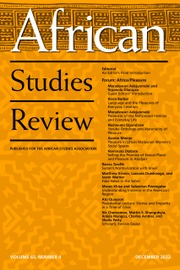The book has multifaceted contributions to the discipline of political science. It engages primarily with international relations theories (IRTs), international human rights law and African regional politics; it also contributes to comparative politics and migration studies. The author problematizes the contradiction between African regional policies and national policies on the rights of migrants and minorities. At the regional level, the African Union (AU) endorses the free movement of peoples and goods through the agreement of African Continental Free Trade Area (AfCFTA) and the Free Movement of Persons Protocol (FMP Protocol); however, African regimes exercise “domination of and discrimination against” minority groups. The author refutes the UN definition of minority that is built on numerical comparison with the majority; normatively, he contends that the definition of minority depends on who—as individual and group—suffer from domination and discrimination. In doing this normative analysis, the author discusses how minority is framed in IRTs, international human rights law, and different political systems.
Regarding the applied method, though the book’s purpose is to provide a normative approach and engaging with theories, the author incorporates quantitative data collection and analysis to demonstrate the perception of migrants in African host countries. Furthermore, the author entangles his analysis of the relevant theorists on minority rights with the implemented policies of international organizations, that is, the UN, EU, and AU. The intermingling of theoretical and practical analyses is present in all eight chapters of the book.
In Chapter One, the author delves into the complexity of identity; noting how practices of inclusion and exclusion determine which group in the country holds the majority and exercises “domination of and discrimination against” minorities. The author illustrates that historical and contemporary dynamics in the continent have shaped “liquid and plural African identities”; thus it is difficult to get permanent factors of domination of minority.
In Chapter Two, the author takes multi-identities feature in Africa to discuss the right of people to take the decision of migration as identity is constructed by history, values and practices. He refutes the theoretical stand that contends the right to migrate is confined by state sovereignty (relational approach); also, he challenges the nonrelational stand that defends the right of people to move. To demonstrate his refutation, the author provides the example of refugees, when the nation state has responsibility to protect and prioritize them over others under normal conditions. Another case is the right to reparation as a privilege for people to migrate to former colonial powers that historically profited from migrants’ countries.
In Chapters Three, Four, and Five, the author turns to empirical analysis of minority rights. Based on survey findings, the author provides a broad overview of migrants in Nigeria, South Africa, and Ghana. The respondents considered AfCFTA as a driving factor in endorsing movements to African countries for economic, professional, and education purposes. Despite that, they have encountered discriminatory policies and behaviors due to different factors including historical/colonial relation, security threats, diseases, and poverty. In Chapter Four, the author discusses why this discrimination occurs by examining Nigeria, as a multi-ethnic country with economic conditions that attract migrants. The legal mechanisms and local government system have consolidated a matrix of domination, which is not practiced only by majority groups over minority groups, but also occurs among “major majority” and “major minority” ethnic groups. To reach “domination-free” society, the author provides in Chapter Five his vision to protect minority rights as a realpolitik. He suggests an enduring “balance of power” among dominant ethnic groups (major majority) to avoid hegemony of one major ethnic group. In this situation, minority groups have the opportunity to secure their gains. Furthermore, minority groups can enhance their positions by building alliance between “major minority” groups and “minor minority” groups to combat the domination and discrimination from the majority groups.
In Chapters Six, Seven, and Eight, the author resituates his argument to regional and international scales. He explains in Chapter Six how arguments of national unity and Western intervention are used to legitimize the “domination of and discrimination against” minority groups in African countries. In Chapters Seven and Eight, the author affirms through engaging with IRTs (statist, internationalist, and cosmopolitan models) how minority rights can be protected by “fusion of horizons” and “subsidiarity.” Adopting that would support mutual acceptance among different groups; additionally, majority group(s) uphold “relational commitment” to support minority groups. African regional relations can straightforwardly incorporate these principles because Pan-Africanism is built on “pluralism” allowing African governing mechanisms to implement them at local, national, and regional levels.
To conclude, the book posits Pan-African politics in dialogue with IRTs; additionally, the author deeply engages with classical theorists to explore the roots of minority policies and to provide his vision to implement AfCFTA and FMP Protocol effectively. While doing that, the author underpins overlooked aspects like discrimination against children in African migration policies which restrict parents’ movement (part of Chapter Three). However, the author does not extend his empirical analysis to the status of white settlers as a minority group when contesting “major majority,” “minor minority” groups, and national policies. Indeed, the author’s contribution is to deconstruct the numerical frame of minority and to consider norms while governing dynamics of domination and discrimination in diverse African societies.


